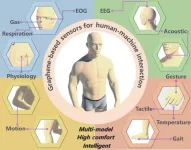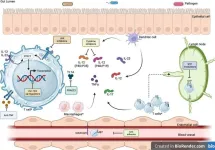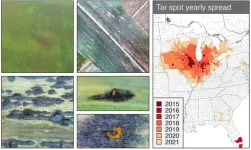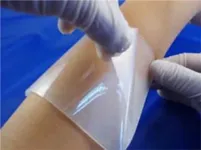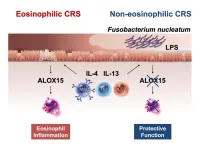(Press-News.org) A new virtual brain bank spanning five Chicago academic medical centers and led by University of Illinois Chicago will create a powerful new resource for clinical care and research on epilepsy, brain tumors and neurological disorders.
A $5 million grant from the National Institutes of Health will create a network of brain tissue research at UIC, Northwestern University, Lurie Children’s Hospital, Rush University and University of Chicago. The institutions will utilize a data platform developed at UIC called INTUITION that combines tissue data with clinical, functional, genetic and 3D imaging information to assist clinicians treating patients and help researchers better understand the mechanisms of brain disorders.
Expanding the INTUITION platform and standardizing brain tissue collection and analysis across the five medical centers will unlock even more opportunities for discovery, said Dr. Jeffrey Loeb, the John S. Garvin Endowed Chair in Neurology at UIC, professor and head of neurology and rehabilitation in the College of Medicine and lead investigator on the project.
“The goal is to turn big data into new therapeutics and biomarkers,” said Loeb, who is also co-director of the biomedical informatics core at the Center for Clinical and Translational Science. “The INTUITION platform is really a way that we can disseminate what we’ve done here at UIC to a larger population of researchers across the city of Chicago.”
In 2017, UIC launched a NeuroRepository to collect and preserve brain tissue surgically removed from patients to treat epilepsy or taken in tumor biopsies. But gathering this valuable tissue is only one piece of the puzzle. To maximize the clinical and research potential, insights from studying the tissue itself must be combined with 3D images and electrical measurements of brain activity, clinical records on the patients’ history and symptoms and data on genetics and other cellular factors.
To integrate all this data into a single system, NeuroRepository team members built INTUITION, a software platform that automatically gathers these disparate data types and combines them into user-friendly interfaces for clinicians and researchers. Neurologists can use the platform to make decisions about surgical treatment for patients, and UIC scientists use its database to gain insights into how seizures start and how to prevent them.
“In traditional research, we often pick one thing to study at a time: an X-ray, or a medical record. But most of the data that we use in clinical practice is multimodal, and all these data are usually siloed from each other,” Loeb said. “We thought if we develop software that’s actually helpful to physicians caring for patients, we will also have highly curated data for research.”
Today, the NeuroRepository contains tissue samples from over 200 patients, which enables researchers to look for common factors across individuals that cause epilepsy and could be targets for new treatment approaches. Bringing INTUITION to other medical centers will dramatically increase that number, enabling larger-scale studies in a more diverse patient population including both adult and pediatric cases.
To ensure the consistency of the data across sites, the project will include educational training to coordinate and standardize procedures for tissue collection and data processing at each location. The INTUITION platform also will be modified to allow federated data sharing — a computational method where researchers can securely query de-identified data stored by different institutions while protecting patient privacy.
“With a federated platform, you can send a probe to each of those sites and ask a question without actually moving any data,” Loeb said. “If you want to look at certain imaging patterns or outcome measures or tissue histologies from patients who have the following age range and types of seizures, you can see what’s available, you can run a federated query and have a result from five sites as opposed to one.”
The first stage of the five-year project will focus on gathering data on temporal lobe epilepsy, establishing INTUITION at the other sites and modifying the platform to best serve clinicians and researchers at all five centers of the network. The second phase will expand its use to study brain tumors and make further improvements to scale the virtual brain bank beyond Chicago.
“You need to test it with multiple programs, with adults and kids, and fix the interface to make it work for different people,” Loeb said. “In the end, we hope we will have a platform that will be robust and can be used at any epilepsy surgery program in the country or the world.”
INTUITION development was supported by funding from the Discovery Partners Institute to create I-BRAIN, an initiative exploring commercialization opportunities around brain tissue data and research. Other UIC researchers on the project include G. Elisabeta Marai, professor of computer science; Dr. Anna Serafini, Biswajit Maharathi, Fozia Mir and Dr. Ahmad Daher from the department of neurology and rehabilitation; Dr. Francesco Pucci from the department of neurosurgery; and Dr. Tibor Valyi-Nagy from the department of pathology.
Written by Rob Mitchum
END
NIH grant expands UIC brain bank into citywide effort to study epilepsy, brain cancer
2023-11-06
ELSE PRESS RELEASES FROM THIS DATE:
Carbon-based sensors are poised to facilitate a seamless human-machine interface
2023-11-06
Interaction between machines and humans is paramount to the development of the new technologies of the metaverse, which are designed to augment the human experience through cloud computing and extended reality (XR). Graphene, a two-dimensional carbon material, has emerged as an ideal candidate for wearable sensor technology, paving the way for a new era of seamless human-machine interaction (HMI).
A team of material scientists led by Tian-Ling Ren from Tsinghua University in Beijing, China recently outlined the state of graphene-based HMI sensor technology ...
Chronic liver diseases: What new insights are there?
2023-11-06
Fatty liver diseases (FLD) have become a significant health concern worldwide, affecting millions. The two most common types of FLD are non-alcoholic fatty liver disease (NAFLD) and alcoholic-associated liver disease (ALD). NAFLD is associated with obesity, insulin resistance, and metabolic syndrome, while ALD is caused by excessive alcohol consumption. Both NAFLD and ALD can progress to liver fibrosis, cirrhosis, and, ultimately, hepatocellular carcinoma (HCC), a primary liver cancer with a poor prognosis.
Significant ...
Future therapies for managing inflammatory bowel disease
2023-11-06
Ulcerative colitis (UC) and Crohn's disease (CD) are chronic inflammatory bowel diseases (IBD) that affect the gastrointestinal tract. In recent decades, there have been significant advances in the understanding of IBD pathophysiology and the development of new treatments.
The International Organisation for the Study of Inflammatory Bowel Diseases (IOIBD) developed the Selecting Therapeutic Targets in Inflammatory Bowel Disease (STRIDE) programs, which recommend specific treatment goals for UC and CD in children ...
A joint research team from South Korea and the United States has identified a new gene classification system for gastric cancer
2023-11-06
- A multicenter study of the MD Anderson, Korea University, Yonsei University, and other institutions
- Establishing subtypes of gastric cancer classification to lay the foundation of personalized treatment
Professor Sang Cheul Oh of the Division of Oncology/Hematology, Department of Internal Medicine, Korea University College of Medicine, Professor Sang‑Hee Kang of the Department of Surgery, Korea University’s Guro Hospital, and Professor Sun Young Yim of the Division of Gastroenterology and Hepatology, Department of Internal Medicine, Korea University College of Medicine announced a new genetic classification system ...
MD Anderson Research Highlights: SITC 2023 Special Edition
2023-11-06
ABSTRACTS: 1534, 777, 1328, 1526, 1330, 545
HOUSTON ― The University of Texas MD Anderson Cancer Center’s Research Highlights provides a glimpse into recent basic, translational, and clinical cancer research from MD Anderson experts.
This special edition features oral presentations from the Society for Immunotherapy of Cancer (SITC) 38th Annual Meeting focused on scientific advances and breakthroughs in cancer immunotherapy from MD Anderson-led studies. Highlights include fecal microbiome transplants ...
Fossils tell tale of last primate to inhabit North America before humans
2023-11-06
LAWRENCE — The story of Ekgmowechashala, the final primate to inhabit North America before Homo sapiens or Clovis people, reads like a spaghetti western: A grizzled and mysterious loner, against the odds, ekes out an existence on the American Plains.
Except this tale unfolded about 30 million years ago, just after the Eocene-Oligocene transition during which North America saw great cooling and drying, making the continent less hospitable to warmth-loving primates.
Today, paleontologists from the University ...
It’s corn! It has the…spots? Researchers supply significant genomic insight into tar spot of corn
2023-11-06
First reported in 2015, tar spot is an emerging disease on corn that has rapidly spread across the United States and Canada, causing tremendous yield loss estimated at $1.2 billion in 2021 alone. Tar spot gets its name from its iconic symptoms that resemble the splatter of “tar” on corn leaves, but these spots are in fact brown lesions formed by the fungal pathogen Phyllachora maydis. This destructive pathogen is challenging to research because it cannot survive outside its plant host; therefore, little information is currently known about the mechanisms that contribute to its disease cycle including spore formation, reproduction, and plant ...
Incheon National University scientists develop new hydrogels for wound management
2023-11-06
Open wounds, whether caused by accidents or from medical procedures like surgery, require proper management to speed up healing and prevent infections. While sutures and staples are common wound closure methods, they can cause secondary tissue injuries, potentially leaking fluids and gases and requiring anesthetics. Tissue adhesive glues are a more attractive alternative but often suffer from toxicity and weak adhesion.
Fortunately, tissue adhesive patches offer an innovative solution. They allow precise control of adhesion and mechanical properties through adjustable polymeric compositions. These patches can also deliver ...
Nasal microorganism to the rescue? Study confirms protective role of bacterium in chronic rhinosinusitis
2023-11-06
Like other countries in the world, Japan has witnessed a worrisome increase in the prevalence of chronic rhinosinusitis (CRS) over the last decade. An inflammatory disease that lasts at least 12 weeks, CRS can cause nasal congestion, nasal discharge, trouble breathing through the nose, facial pain, and even loss of sense of smell. Unfortunately, treating CRS is complex since the disease manifests in various forms. CRS can be categorized into eosinophilic (ECRS) or non-eosinophilic (non-ECRS) types. In ECRS, the nasal and sinus tissues exhibit an increased presence of eosinophils, a type of white blood cell that releases inflammatory ...
American Indian and Alaska Native adults had higher rate of premature heart attack deaths
2023-11-06
Research Highlights:
American Indian and Alaska Native adults had significantly higher death rates from premature heart attacks compared to white, Black and Asian/Pacific Islander adults in the U.S., according to an analysis of more than 370,000 heart attack deaths from 1999-2020.
In addition, despite an overall decrease in heart attack death rates among American Indian and Alaska Native adults during the last two decades, heart attack-related deaths in American Indian and Alaska Native adult men younger than 55 years old and women younger than 65 years old did not decrease.
Embargoed until 4 a.m. CT/5 a.m. ...
